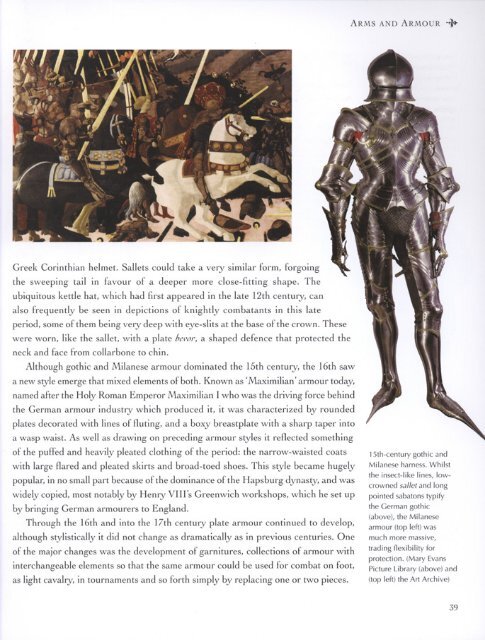Osprey - General Military - Knight - The Warrior and ... - Brego-weard
Osprey - General Military - Knight - The Warrior and ... - Brego-weard
Osprey - General Military - Knight - The Warrior and ... - Brego-weard
You also want an ePaper? Increase the reach of your titles
YUMPU automatically turns print PDFs into web optimized ePapers that Google loves.
Greek Corinthian helmet. Sallets could take a very similar form, forgoing<br />
the sweeping tail in favour of a deeper more close-fitting shape. <strong>The</strong><br />
ubiquitous kettle hat, which had first appeared in the late 12th century, can<br />
also frequently be seen in depictions of knightly combatants in this late<br />
period, some of them being very deep with eye-slits at the base of the crown. <strong>The</strong>se<br />
were worn, like the sallet, with a plate bevor, a shaped defence that protected the<br />
neck <strong>and</strong> face from collarbone to chin.<br />
Although gothic <strong>and</strong> Milanese armour dominated the 15th century, the 16th saw<br />
a new style emerge that mixed elements of both. Known as 'Maximilian' armour today,<br />
named after the Holy Roman Emperor Maximilian I who was the driving force behind<br />
the German armour industry which produced it, it was characterized by rounded<br />
plates decorated with lines of fluting, <strong>and</strong> a boxy breastplate with a sharp taper into<br />
a wasp waist. As well as drawing on preceding armour styles it reflected something<br />
of the puffed <strong>and</strong> heavily pleated clothing of the period: the narrow-waisted coats<br />
with large flared <strong>and</strong> pleated skirts <strong>and</strong> broad-toed shoes. This style became hugely<br />
popular, in no small part because of the dominance of the Hapsburg dynasty, <strong>and</strong> was<br />
widely copied, most notably by Henry VlII's Greenwich workshops, which he set up<br />
by bringing German armourers to Engl<strong>and</strong>.<br />
Through the 16th <strong>and</strong> into the 17th century plate armour continued to develop,<br />
although stylistically it did not change as dramatically as in previous centuries. One<br />
of the major changes was the development of garnitures, collections of armour with<br />
interchangeable elements so that the same armour could be used for combat on foot,<br />
as light cavalry, in tournaments <strong>and</strong> so forth simply by replacing one or two pieces.<br />
ARMS AND ARMOUR •*}*•<br />
1 5th-century gothic <strong>and</strong><br />
Milanese harness. Whilst<br />
the insect-like lines, low-<br />
crowned sa//ef <strong>and</strong> long<br />
pointed sabatons typify<br />
the German gothic<br />
(above), the Milanese<br />
armour (top left) was<br />
much more massive,<br />
trading flexibility for<br />
protection. (Mary Evans<br />
Picture Library (above) <strong>and</strong><br />
(top left) the Art Archive)<br />
39







